In November, 89.7 WTMD, held a party to commemorate 15 years of its current iteration as Towson University’s FM radio station.
However, TU’s exploration and experimentation with radio has been a story almost 50 years in the making and encompasses many more call letters than WTMD.
An Idea
In October 1970, a committee made up of both students and faculty members at Towson State College (TSC) met and began talking about what a radio station on campus would look like — what support would it need, who would work in the station, how would it broadcast, and how far would that broadcast travel.
TSC itself was a fairly new concept, as the change to a liberal arts school from a teachers college occurred in 1963. Since that change, curricular programming had evolved, enrollment was booming, and the campus itself was expanding to keep up with both of those things. Supporting students’ varied interests and finding innovative ways to connect the campus became more necessary during this phase of development. Creating a radio station was a natural progression.
A Towerlight article from 1971 reported that “Rick Dudley, a TSC student, voiced first interests in the idea to Mr. Robert Keane,
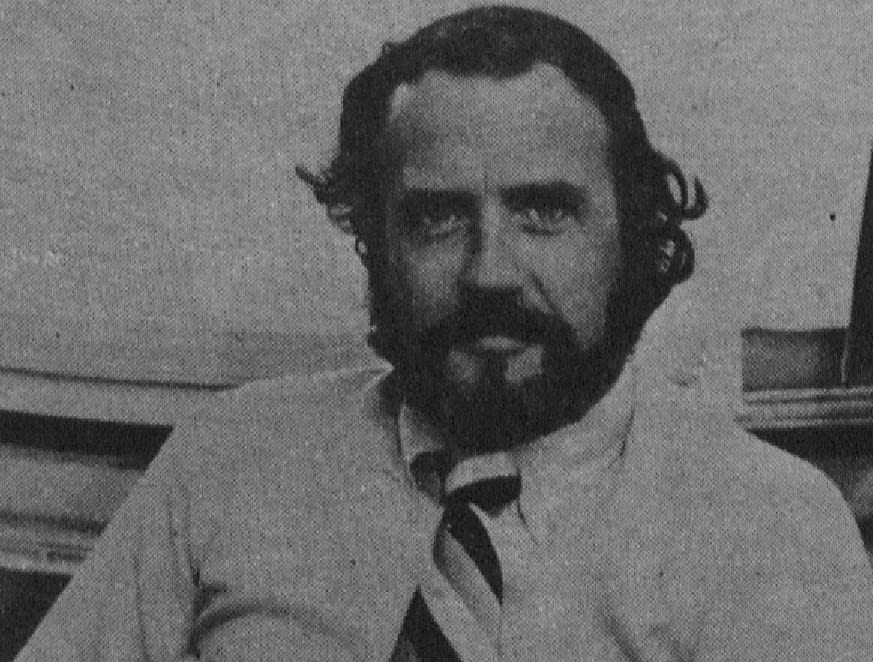
a faculty member of the Speech-Mass Communications Departments. During the summer of 1970 Keane and Dudley began researching rules of the Federal Communications Commission, and equipment specifications in various electronic catalogs.”
The idea was soon supported by the campus administration, faculty, and the Student Government Association (SGA). That fall “a special radio committee was established in the office of Vice President Richard Gillespie’s office at the urging of Student Government President, Richard Neidig, who backed a radio station as a goal of his administration. Members of the subcommittee included Keane and Dudley, SGA Senator and chairman of the committee, Wayne Miskelly, Mr. William Carey of the Office of News & Publications, Wayne Kirwan, Public Relations Director of the SGA, and James Duffy, Assistant Director of the College Union.”
Ultimately, it was decided that the most expedient solution would be to create a “closed loop system’ for an AM channel. Special cables and transmission boxes would be installed and when radios were plugged into these wired systems, the station would be available to listeners. This meant that the school didn’t have to go through the Federal Communications Commission (FCC) to broadcast. The loop system would be put into place first at the Union and then in the dormitories.
Faculty members from the Communication Arts and Sciences and later the Mass Communication departments served as advisers but the station itself would be run by students. They would not only be responsible for each day’s broadcast, but would also serve as music and operations managers. They would decide on what programs to create based on their own interests, and hope that those mirrored what their peers wanted to listen to.
The money to pay for it all would come from the SGA with some money from the college departments for programs that focused on education.
While coming up with ideas was somewhat easy, putting those ideas into action proved harder. The plan was ready to go by the fall of 1971, but floundered due to trouble raising money to install the transmission cables and boxes. By the winter of 1972, it was decided that while the broadcasts would still happen in the Union and the dorms, the broadcasting station would actually be housed in the Media Center.
By that point, the station had its first call letters: WVTS – the Voice of Towson State.
WVTS
WVTS began broadcasting in the student union, then called the College Center, in the spring of 1972. By September, the schedule was solidified — Monday through Friday from 8am until 6pm, the station aired shows with “everything from the Top 40 to underground rock, sports and local, state and national news.”
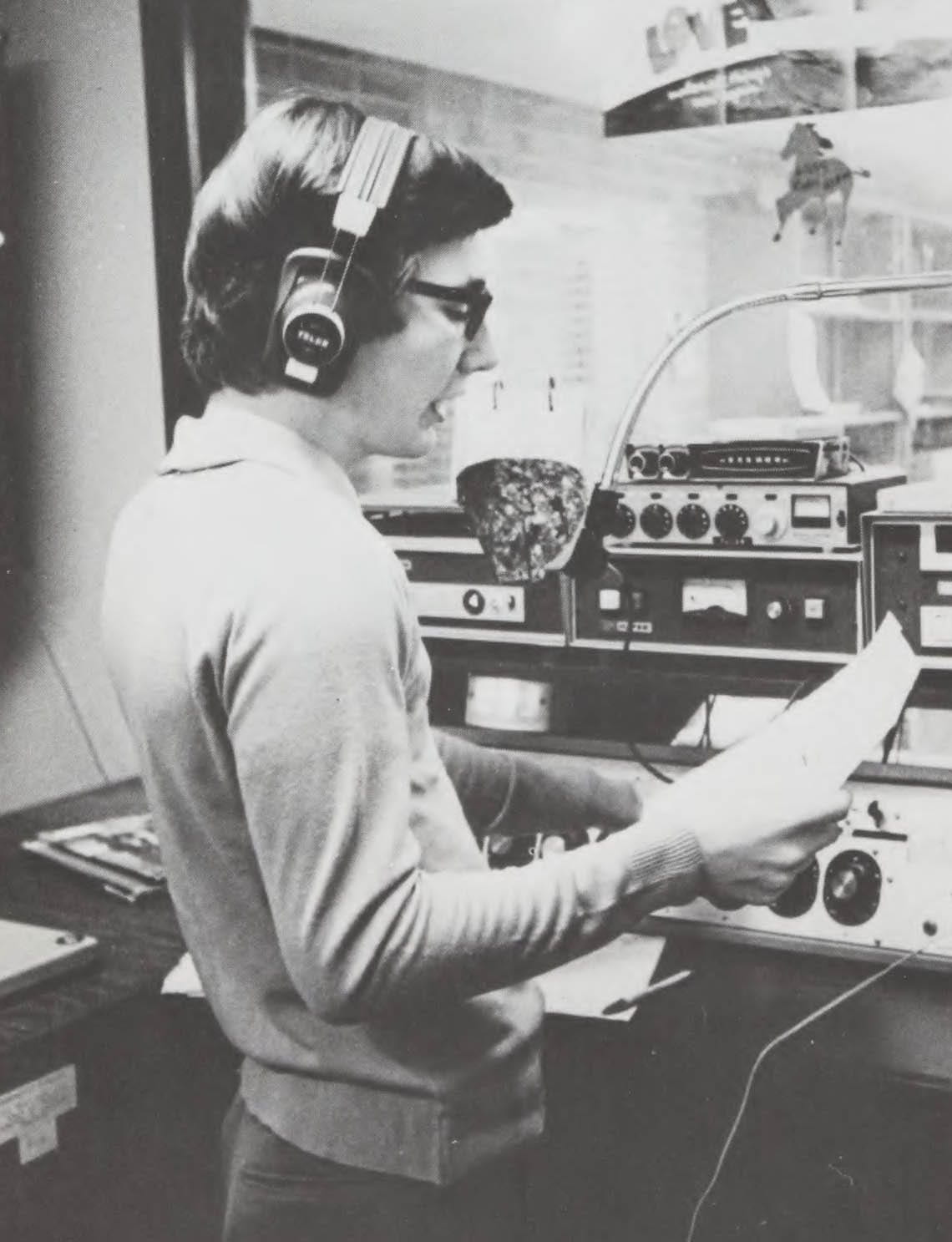
Meanwhile, plans were underway to create an FM station on campus. At first, TSC tried to find an available channel in a pretty dense market. Apparently there were only two channels available. A 1973 letter in the Towerlight bemoaned the school’s lack of response:
Somehow Towson’s attempts to acquire the necessary money to begin broadcasting got bogged down on the other side of Osler Drive. Since then both frequencies have been scarfed up, one by Harford Junior College and the other by Sparrows Point High School. Towson was beat out by a junior college and a high school — doubly shameful.
Next, TSC collaborated with Morgan State University to create a station the two schools would share. However, Morgan was well ahead in the planning and eventually dropped the partnership with Towson to launch WEAA, 88.9FM.
The 1973 letter went on:
Now there is no room left anywhere for another FM station. Towson, the center for mass communications in the state college system, must settle for WVTS, or what someone has called “the most sophisticated intercom I’ve ever seen.”
In the fall of 1973, the search for an FM station began again and the SGA granted WVTS $25,000 to be used to pay for equipment and licensing. The hope was that the FM channel would reach more people both on and off campus and that the disc jockeys would step up their game on the new station.
Since the beginning of broadcasting on WVTS, there had been criticism from many corners: staffers at the Towerlight were concerned that WVTS was encroaching on their territory, other campus members felt that WVTS wasn’t covering enough on-campus events or being inclusive, and there was an overall worry about a perceived lack of professionalism in the broadcast booth. One DJ was suspended for performing “a show on the air while under the effect of alcoholic beverages”, reported a May 1973 Towerlight article.
Among the offenses allegedly performed by the disc-jockey was the playing of his identification tape twice in a row, attempting to talk with several “friends” in the Residential Tower via the airwaves, and playing songs of poor taste, specifically a number by Frank Zappa and the Mothers of Invention.
WCVT – Bach to Rock
In September of 1974, the FCC approved new call letters for the FM station which were also adopted by the AM station. WCVT stood for “the communications voice of Towson”. It was understood as well, that the FM station would be a non-commercial station. By the end of that year, a format for the FM station was approved by an advisory board. While the main thrust of the station would be “progressive”, there would be slots open for a variety of other programming. A December 1974 Towerlight article reported that “The proposed format also provides for special features including bluegrass, live concerts, soul and black awareness, country and western, folk, comedy, sound tracks and nostalgia.”
More delays prevented the FM station broadcasting as intended in the spring of 1975 — a company hired to construct the radio tower declared bankruptcy so the bidding had to reopen. When the transmitter finally was constructed and put into place, FCC regulations insisted on tests to make sure it was working properly, further delaying the start of broadcasting on campus and beyond.
Finally, FM
On February 12, 1976, WCVT-FM hit the airwaves. The first song played was “Bop City Revisited” by Hank Levy and played by the Towson State College Jazz Ensemble.
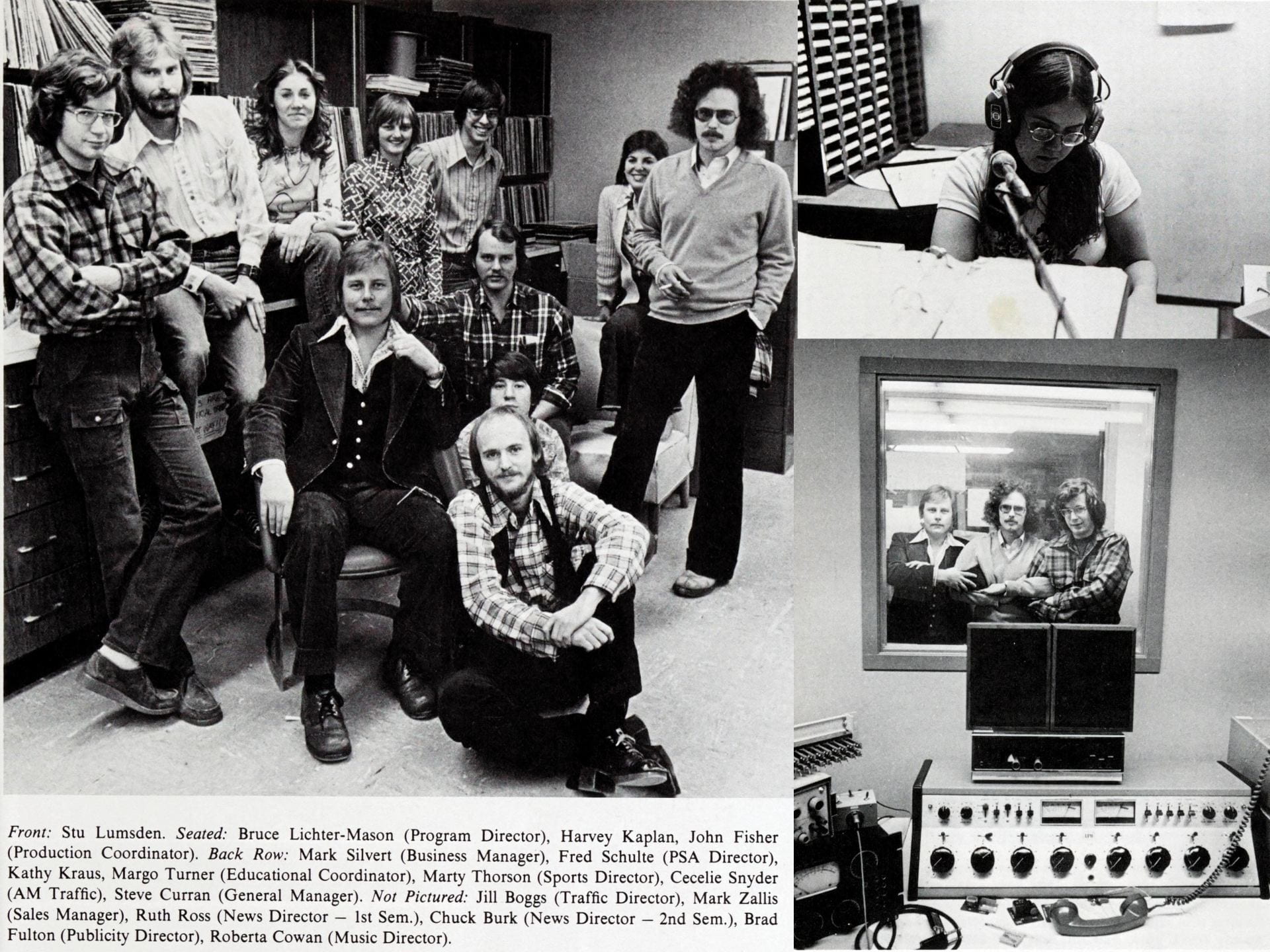
With the advent of the FM station, WCVT-AM was turned into a “training” station. Anyone who wanted to be on the radio had been able to broadcast on the AM station, but now it was the channel students used to learn how to run the broadcast board before making the leap to the FM station. By 1978, the closed-loop system had expanded to the Residence Tower, Prettyman, Scarborough, Richmond and Newell. Fred Schulte, the General Manager of the station at the time told the Towerlight “The carrier current system has been installed for about eight years but ‘we just got all the transmitters working'”.
Running both stations was costly. While students managing the station and broadcasting the shows were essentially volunteers, keeping the equipment updated was a constant challenge. In 1978, WCVT held its first annual fundraiser, netting about $3,700. By 1981, the station began offering gifts in exchange for donations — a practice that continues until today.
In August of 1981, the AM station changed its name to WTSR-56 AM — Where Towson State Rocks. The AM station specialized in listener requested songs, covered many campus sporting events, and eventually became a “top 40” popular music station with some “oldies” mixed in.
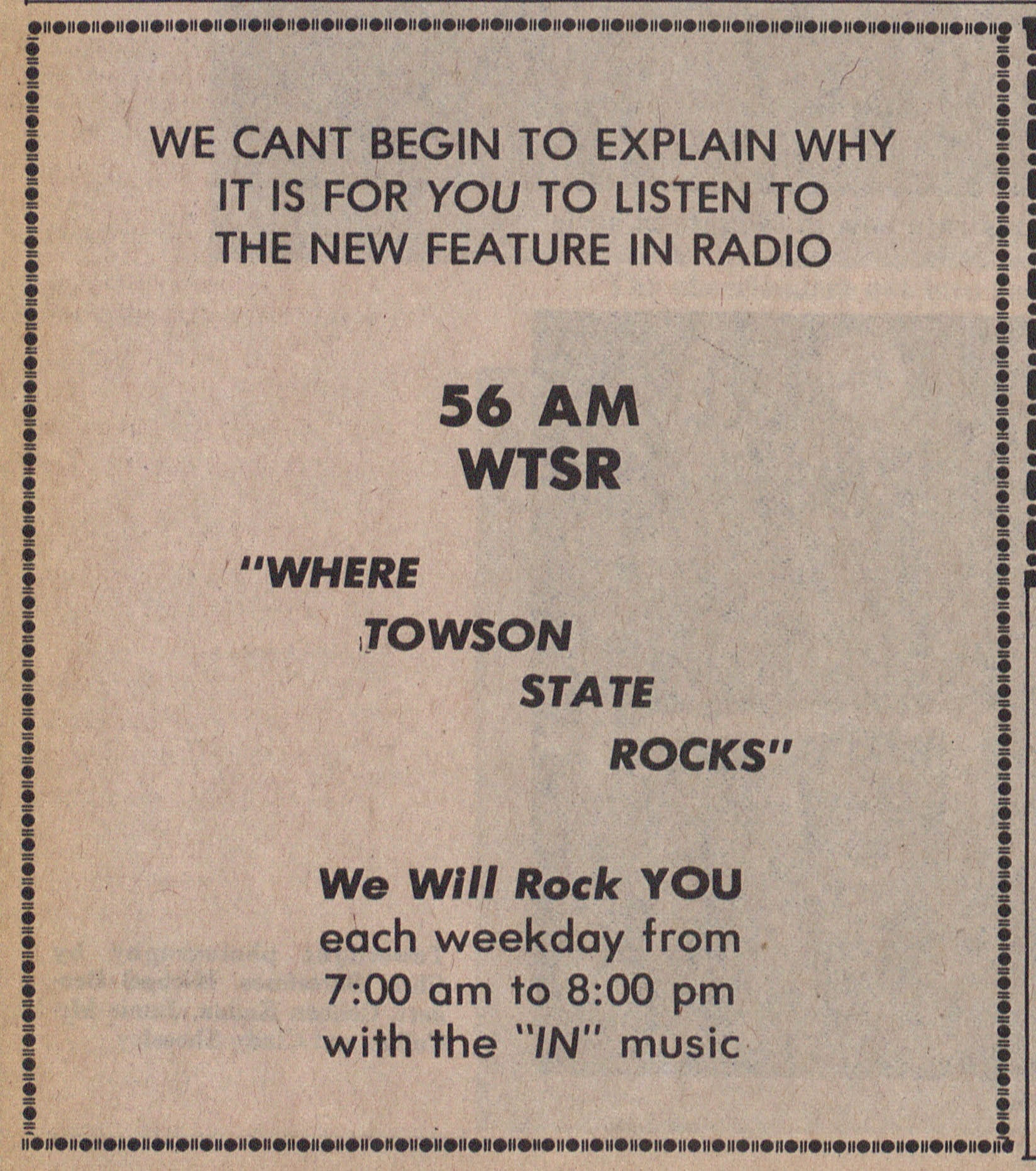
Turning Up the Power
The fundraiser in 1981 focused on acquiring a new transmitter for the FM station, and over the next few years WCVT began to focus on extending the reach of the FM station’s broadcast. In February of 1983, the Towerlight reported that the station had learned they could “boost the power to 10,000 watts and cover about an 80 mile radius.”
“I’m a bit surprised that our consulting engineers found the power anyway,” said John Mackerron, WCVT’s advisor. “Much of the time we’ve spent in these past four years has been spent in looking for a higher place for our antenna and unfortunately we haven’t been able to do that, so we made a decision to go ahead with our power increase.”
It would take another year and many more fundraising and SGA dollars, but eventually the tower was put into place and a more powerful transmission began.
The increased power again strained the existing budget of the station. Fundraising efforts began to fail, perhaps because the goal was too high for college students to support or perhaps because of competition from local radio stations like 99.1 WHFS which also played alternative music.
In 1988, the administration at TSU allocated money for the first time to WCVT. $150,000 was budgeted to “professionalize the management” of the FM station. Within a year, two paid positions were in place — a part-time general manager position and full-time program director. And new studios for both WCVT and WTSR were created in the Media Center with upgraded equipment. A February Towerlight article reported:
The news broadcasting studio has a reconditioned console, two cartridge tape recorders, a reel-to-reel tape recorder, cassette player, and a new equilizer [sic]. The phone system has been upgraded to allow the recording of voice actualities for newscasts. The news studio is situated so the newscaster can observe both the FM and AM disc jockeys through a pair of windows, which was not possible from the old studio.
For the next three years, the FM station continued to garner attention as one of the most progressive stations in the area, winning accolades from outside campus.
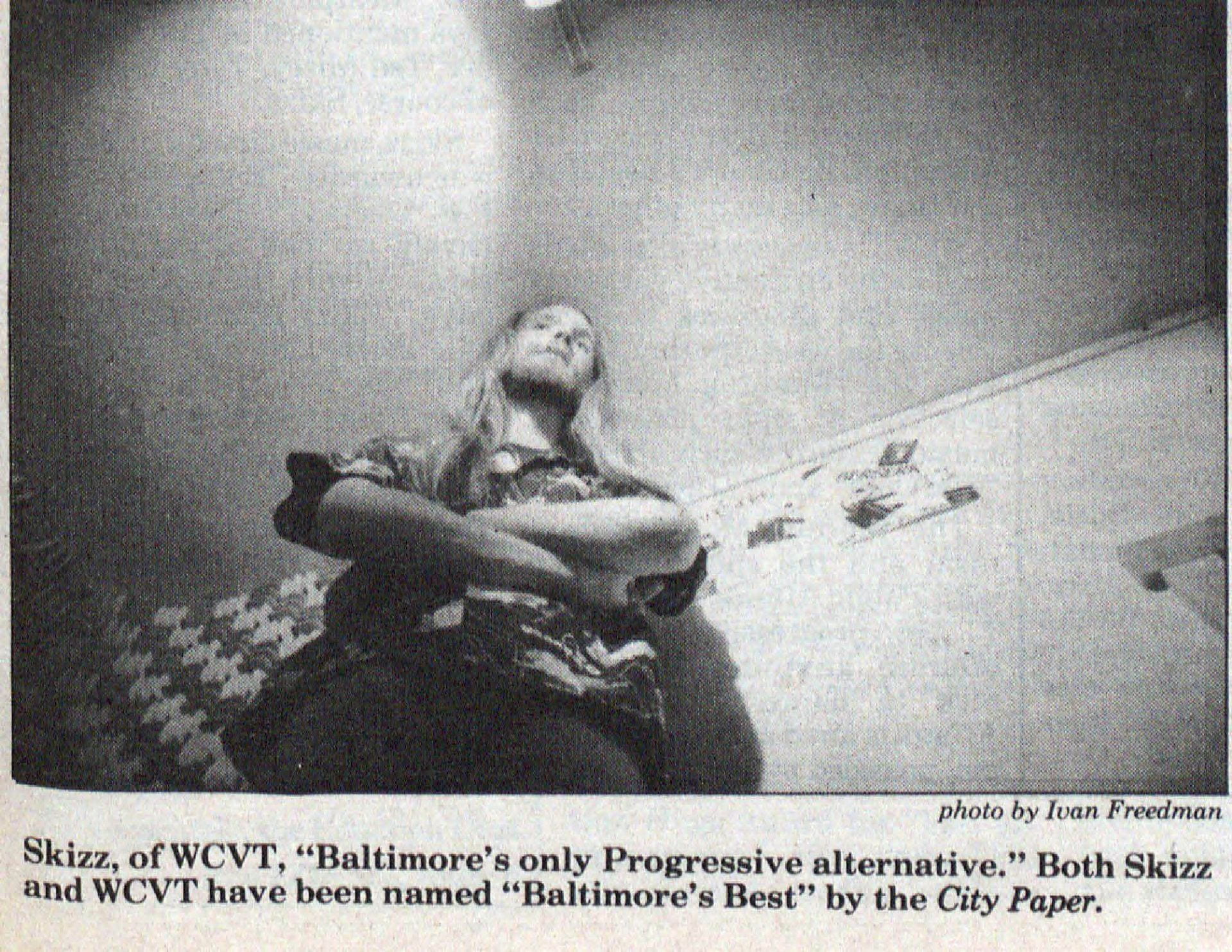
But revenue was still an issue. Because of the strange position the station held — student organization, educational experience, and entrepreneurial endeavor — it seemed to run afoul of the many agencies it had to answer to, particularly in terms of funding. More than once the SGA threatened to pull money because WCVT hadn’t sent representatives to budget meetings.
And then in the summer of 1991, everything changed.
WTMD – The Breeze
First, the call letters changed. WCVT became WTMD — “Where Towson Makes a Difference” — and was known as “The Breeze”. But more significantly, the programming for the station was completely overhauled. Gone were the progressive and alternative shows with the mix of “polka, Irish, cosmic, hard-core, 60s and 70s, punk, and folk music”. Now in place was a format of “new age, jazz, and adult contemporary music.”
The general manager said that the station had been conducting surveys to determine what the public wanted to hear. And the surveys suggested that there weren’t many people listening to what students were playing at WCVT. With the change in programming, it was hoped that more people would tune in.
Interviews and multiple letters to the editor of the Towerlight reflected disappointment in the format change: “WCVT was the best thing Baltimore had going for it and now it doesn’t exist,” said Skizz, former WCVT program coordinator. “When they switched they really let a lot of people down.” There was a belief that because student fees paid for the station, it should play what students wanted.
But the station management didn’t agree: “It’s not the students’ station,” said [music coordinator Dave] Robinson. “It’s [sic] main purpose is to help students learn radio – not to entertain students.” And the need to reach people beyond campus in order to raise the funds to keep the station running meant that the students’ wants were considered less important.
In the meantime, WTSR was slowly transitioning from its Top 40 and Golden Oldies format to one that echoed what WCVT had been — multi-formatted programming that was more reflective of what students were listening to. It still served as the training ground for WTMD, however. By 1995, the station was known as “The Edge” and was playing an eclectic mix of “rock, pop and soul” the following year.
WTMD – Radio For Music People
On December 3, 2002, WTMD changed again. It switched from the adult contemporary format it had been playing for over 10 years to “Triple A” — Adult Album Alternative. Again, the change was made after surveys were done to see what would best fit with the desired donation demographic. And while students were no longer the main DJs, they were often employed by the station or served as interns. In 2004, the station began holding its iconic “First Thursdays Concerts” which have most recently been held at Canton’s Waterfront Park.

In 2012, WTMD moved from its old studios in the Media Center on campus to a larger facility at 1 Olympic Place near the Towson circle. And in 2014, it became part of Towson University Public Media nonprofit — a step that allowed it to be a managed separately from the school while remaining in ownership of Towson University.

WTSR transitioned to an internet station, XTSR, in 2004. It is still listed as a student group in the Department of Mass Communication.
WTMD just finished celebrating 15 years in its current format. It has grown to be a mainstay of the Greater Baltimore area.
Happy Birthday, WTMD!
